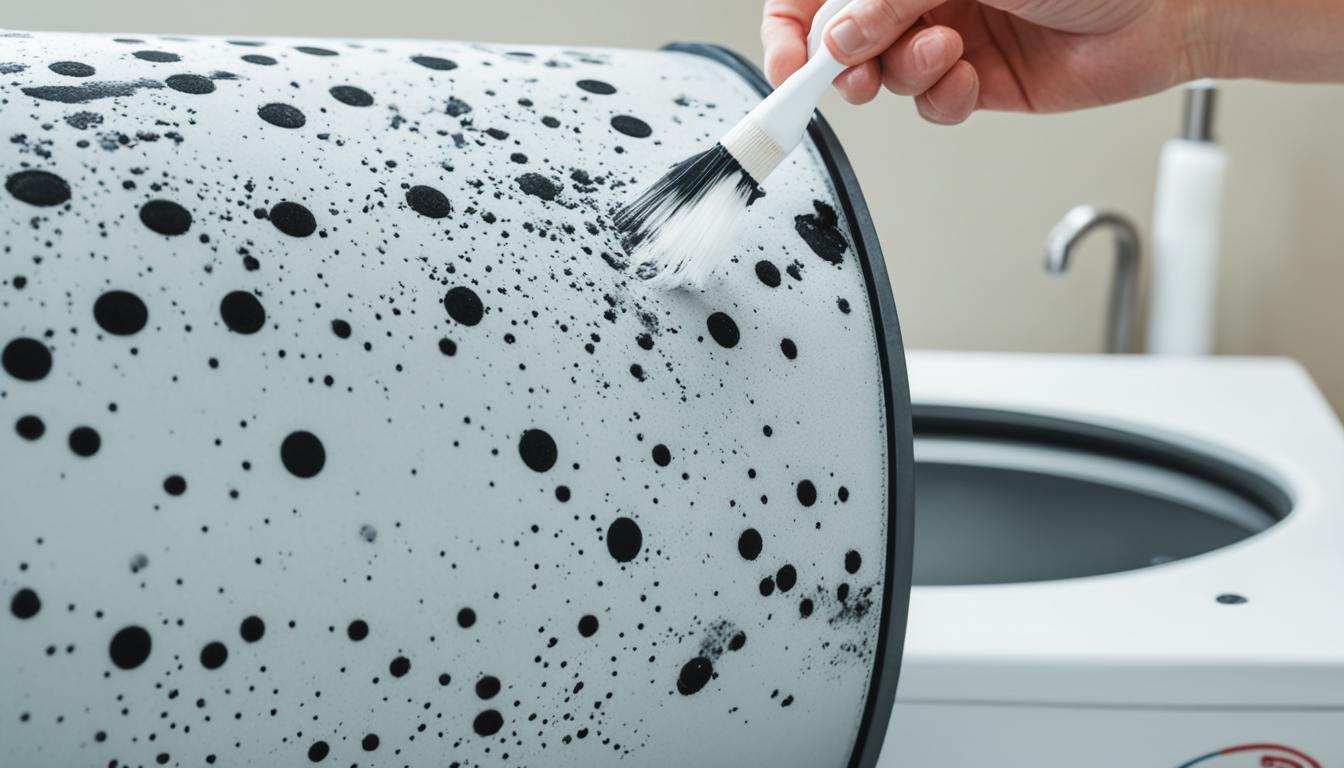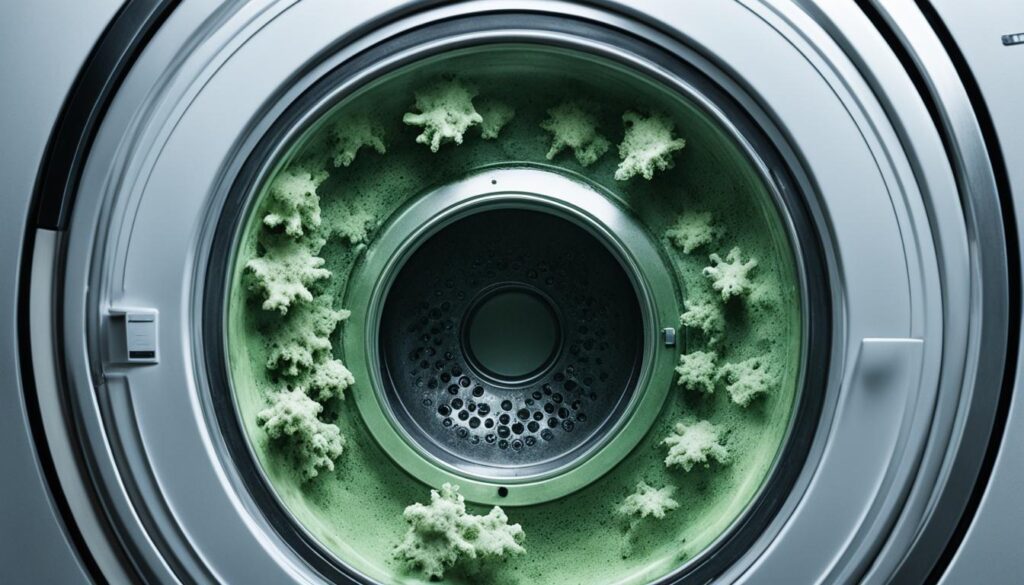
Exploring the World of how to clean Mold from washing machine: A Beginner’s Guide
Welcome to our comprehensive beginner’s guide on how to clean mold from your washing machine. In this article, we will provide you with essential strategies and techniques to effectively remove mold from your washing machine. Not only will you learn the importance of mold removal for maintaining laundry hygiene, but we will also delve into valuable tips for washing machine maintenance.
Cleaning mold from your washing machine is a critical step in ensuring a healthy and clean laundry experience. Mold growth in washing machines can lead to unpleasant odors, stains on clothes, and even potential health risks. Therefore, understanding the impact of mold and knowing how to address it becomes vital for every household.
Key Takeaways:
- Regularly cleaning your washing machine is crucial for maintaining laundry hygiene.
- Mold in washing machines can lead to unpleasant odors, stains, and health risks.
- Effective mold removal techniques include using vinegar, bleach, and baking soda.
- Proper washing machine maintenance helps prevent mold growth and ensures efficient performance.
- By following the guidelines in this guide, you can enjoy a mold-free and fresh laundry experience.
Understanding the Impact of Mold in Washing Machines
Before diving into the cleaning methods, it is crucial to understand the impact of mold in washing machines. Mold growth in washing machines can have detrimental effects on both the machine itself and the overall cleanliness of your laundry.
Mold growth:
Mold thrives in damp environments, and washing machines provide the perfect conditions for its growth. The warm and moist environment inside the machine, combined with residual moisture left in the drum or detergent drawer, creates an ideal breeding ground for mold.
Health risks:
Mold spores released by the growth can pose health risks to you and your family. Exposure to mold spores can cause respiratory problems, allergies, and irritation of the eyes, nose, and throat. People with pre-existing respiratory conditions, such as asthma, may experience worsened symptoms when exposed to mold.
Moisture buildup:
Moisture buildup in washing machines can contribute to mold growth. Factors such as using excessive detergent, not leaving the door open to allow air circulation, or insufficient cleaning of the machine can lead to excess moisture inside, providing the perfect conditions for mold to thrive.
To visualize the impact of mold growth in washing machines, refer to the table below:
| Impact of Mold in Washing Machines | Consequences |
|---|---|
| 1. Mold growth | – Foul odor on clothes – Stains on fabric – Allergic reactions – Potential damage to the machine |
| 2. Health risks | – Respiratory problems – Allergies – Irritation of eyes, nose, and throat – Worsened symptoms for asthmatics |
| 3. Moisture buildup | – Ideal environment for mold growth – Excess moisture in the machine – Inefficient cleaning of laundry |
Understanding the impact of mold in washing machines emphasizes the importance of regular cleaning and maintenance. In the next section, we will provide a step-by-step guide on how to effectively clean mold from your washing machine and prevent its reoccurrence.

Step-by-Step Guide: How to Clean Mold from Washing Machine
If you’ve discovered mold in your washing machine, it’s crucial to take immediate action to prevent it from spreading and ensure proper hygiene. Follow this step-by-step guide to effectively clean mold from your washing machine and maintain its cleanliness.
1. Gather the necessary materials
Before you begin the cleaning process, gather the following materials:
- Vinegar
- Bleach
- Baking soda
- Gloves
- Scrub brush
- Microfiber cloth
2. Empty the washing machine
Remove all clothing and accessories from the washing machine and ensure it is completely empty.
3. Prepare the cleaning solution
Create a cleaning solution by mixing equal parts vinegar and water in a spray bottle. For more severe mold infestations, add a small amount of bleach to the solution. Alternatively, you can create a paste with baking soda and water.
4. Clean the detergent dispenser and drum
Start by removing the detergent dispenser and soaking it in a mixture of vinegar and water. Scrub away any mold or residue using a brush or cloth. Inside the drum, spray the vinegar solution or apply the baking soda paste to any visible mold or mildew. Allow it to sit for a few minutes before scrubbing with a brush.
5. Wipe the rubber gasket and door seal
Carefully inspect the rubber gasket and door seal for mold growth. Wipe them thoroughly with a cloth soaked in vinegar or bleach solution. Pay close attention to the crevices and folds where mold tends to accumulate.
6. Run a cleaning cycle
Fill the washing machine with hot water and add two cups of vinegar or bleach. Run a complete wash cycle, using the longest and hottest setting available. This will help eliminate any remaining mold and remove odors from the machine.
7. Remove residue and dry the machine
Once the cleaning cycle is complete, inspect the drum and rubber gasket for any remaining residue. Wipe them clean with a cloth soaked in water. Leave the washing machine door open and allow it to air-dry completely to prevent moisture buildup.
8. Prevent future mold growth
To prevent future mold growth in your washing machine, follow these preventive measures:
- Leave the door open after each wash to allow air circulation and reduce moisture.
- Clean the detergent dispenser regularly to prevent residue buildup.
- Remove wet clothes promptly after washing to prevent dampness.
- Perform monthly or quarterly maintenance cleanings using vinegar or bleach.
By following these steps and incorporating preventive measures, you can keep your washing machine mold-free and ensure clean and hygienic laundry every time.

Conclusion
In conclusion, maintaining a mold-free washing machine is vital for ensuring laundry freshness and upholding hygienic washing practices. By diligently following the cleaning methods and preventive measures outlined in this guide, you can successfully keep your washing machine free from mold and enjoy clean and fresh laundry every time.
Regular washing machine maintenance is paramount in preventing mold growth. By examining and cleaning the detergent drawer, rubber gasket, and other hidden areas of your machine, you can eliminate any trapped moisture or residue that may contribute to mold formation.
Additionally, incorporating simple practices like leaving the washing machine door open after each use and running an empty cycle with hot water and vinegar can further discourage mold infestation. These small steps can go a long way in preserving the longevity of your washing machine and ensuring the optimal performance of each wash.




